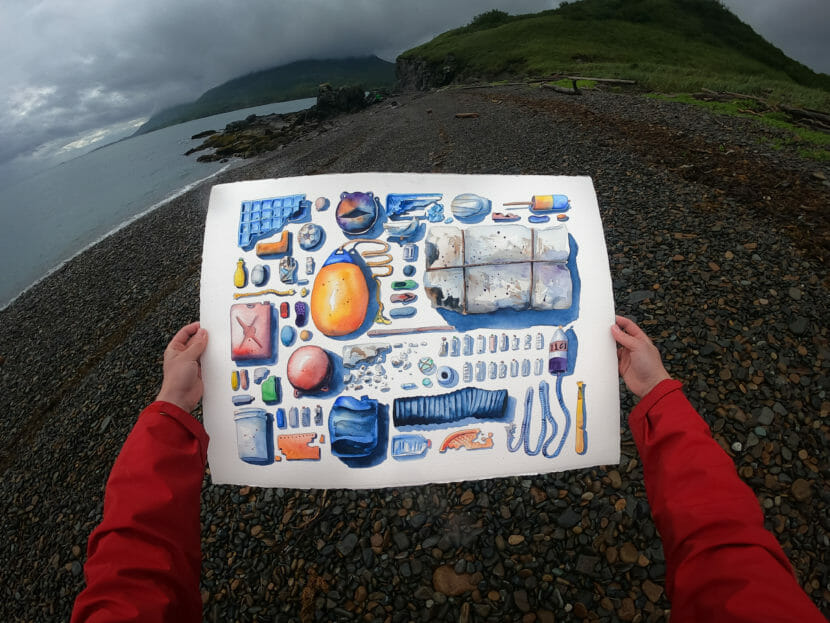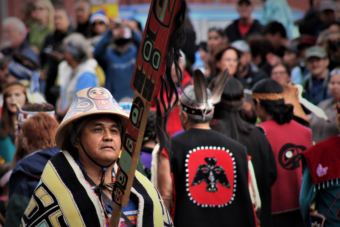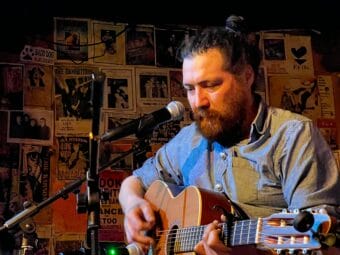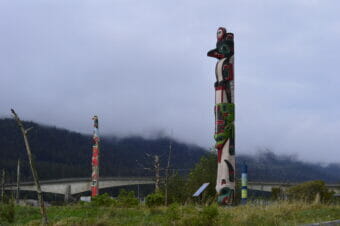
An Alaskan painter and videographer has released a short film about the dangers of ocean plastic.
It’s called “If You Give a Beach a Bottle,” it’s by Max Romey and it incorporates scenes of volunteers cleaning up Alaska shorelines littered with marine debris, coupled with images from Romey’s watercolor sketchbooks.
Romey says the title is a reference to the children’s book, “If You Give a Mouse a Cookie,” because the issue of plastic in the ocean seemed like a similar, circular, never-ending story.
That’s after Romey started going on trips to Alaska beaches remove tons of washed up debris.
Listen here:
The following transcript has been lightly edited for clarity.
Max Romey: Alaska has these islands, which kind of stick out and scoop this stuff all up. And so it was this completely overwhelming experience. For the last seven years, it’s just been kind of sitting in the back of my head. And this is one of the first times where I went back out, this time with a sketchbook, and kind of just tried to tell a story of this huge, huge thing. And this is one of the first times I’ve been able to share the film publicly. This is very much just the first step in what is probably going to be a journey that I might not see the end of until you know, I’m 90 or 100.
Casey Grove: You’re in deep now.
Max Romey: I am indeed now, yes. We’ll see where this goes.
Casey Grove: Am I understanding this correctly, that it started with a sketchbook and watercolor, right?
Max Romey: Yeah, well I guess my whole journey with this started with a sketchbook and watercolor. I’m really dyslexic. So I struggle with reading and writing. My handwriting is close to illegible, but the spelling makes it even worse. And that’s where sketchbooks came in. My grandmother is an amazing painter, and my whole family really encouraged me to get into art, because you can’t really misspell a painting. People see it, they understand it, doesn’t matter if they speak English, or like, speak nothing at all, people understand sketches. And so from age six to now I’ve been kind of sketching this whole time, but rarely have actually used it in films. And all the sudden, these giant complex issues that words had no real way to capture, I’m finding that sketches could get a grasp of of these things that that words really couldn’t.
Casey Grove: (If You) Give a Beach a Bottle, it’s about five minutes or so right? And you’re showing your progress on the art that you’re making while the beach cleanup is going on, and some of the negative aspects of that and animals that are affected by it and whatnot, affected by marine debris. And then also just these beautiful landscapes. It seems like the things that you decided to sketch were sort of crystallized, bigger ideas that then had maybe more impact, just in those those moments in the film like that. I mean, having seen it for yourself and spent so much time looking at this problem. How big is it?
Max Romey: Marine debris is like a slow motion tsunami that’s hitting Alaska. And it’s nets, it’s lines, but it’s also bottles, it’s buoys, it’s barrels, it’s coolers, it’s Styrofoam. Everything is made out of plastic, nowadays, all over the world. Stuff gets thrown away, a lot of this is coming from rivers, so it goes into a landfill, landfill is not very good, landfill ends up in the river, river ends up in the ocean. Or it just gets dumped directly into the ocean. That happens, too. But then plastic will never break down, it will only ever break up. And so as it ends up in the ocean, the ocean currents kind of spin around, and then Alaska is just stuck out right in the middle, like putting your hand into a washing machine full of clothes. And it just kind of captures all of this. These winter storms just blow it all up on shore.
We’re kind of this cheese grater that all of these ocean plastics are ending on, and we just shred them into all these tiny pieces. And then these tiny pieces are, once they get small enough, they bioaccumulate, they pick up a lot of toxins and they end up back into the environments that these cycles of nutrients make possible. The salmon go up the stream, they die, all that nitrogen from the ocean goes up, the bears eat ’em, the eagles eat ’em. Most of the trees have these salmon nutrients in them. But we’re basically injecting plastic into this whole situation. So once these things are broken down into trillions of little pieces, you lose them.
Right now, you could go to the beach, you could go to Cordova, you could go to Kodiak, Katmai, and you can find big, big piles of bottles and buoys, and you can pick them up. But the scary part is what you don’t find, all of those things that have been broken up into thousands of pieces. And then that will build up in a lot of these systems. And by the time it builds up, when we actually see it in the nature, it’s too late. It’s this funny little time where you can actually do something about it now, but it’s super complex, it’s really hard to see and it’s slow moving. So it’s not like, you know, an oil spill. It’s like asbestos. This stuff is gonna affect Alaska for a very long time, and we have a chance to kind of do something about it now. But the longer we wait, the harder it’s going to be.
Casey Grove: And a lot of people don’t see that every day. I mean, it sounds like it kind of changed how you thought about it to see it up close and personal and be out there on the beach like that.
Max Romey: Yeah. You see buoys, you see things that you don’t see every day, but you also see laundry baskets, you see dish detergent bottles, you see lunch containers, and you see pieces of all this as well. The big pieces are just what you could pick up, that’s not too late. The little pieces, it’s gone. But you see all this stuff and you realize this came from somebody’s car, this was in somebody’s trash can, somebody ate off of this plate and now it’s in Alaska for some reason. So it’s this major global problem, and we could have people picking up these beaches 24/7, all day every day for years, and we wouldn’t get it all.



